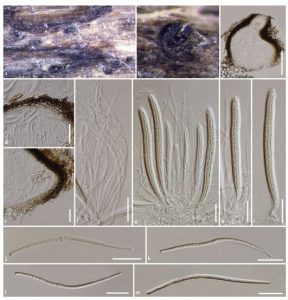Pseudoophiobolus subhyalinisporus Phookamsak,Wanas., Camporesi & K.D. Hyde, sp. nov. Index Fungorum number: IF553929
Etymology: The specifific epithet ‘‘subhyalinisporus’’ refers to the species having subhyaline ascospores
Holotype: MFLU 17-0923
Saprobic on herbaceous plants. Sexual morph: Ascomata 140–240 µm high (excluding papilla), 200–310 µm diam., dark brown to black, scattered, solitary, semi-immersed to erumpent through the host epidermis, globose to subglobose, or ampulliform, uni-loculate, glabrous, ostiolate, papillate. Papilla 80–105 µm high, 70–105 µm diam., mammiform to oblong, with truncate apex, composed of 3–5 layers of dark brown to black, pseudoparenchymatous cells, arranged in a textura angularis, ostiole central, with indistinct hyaline, periphyses. Peridium 10–30 µm wide, slightly thicker at the base, composed of several cell layers of hyaline to dark brown, pseudoparenchymatous cells, with dense, hyaline cells at the base, arranged in textura angularis to textura prismatica. Hamathecium composed of dense, 2–3 lm wide, cellular pseudoparaphyses, indistinctly septate, not constricted at the septa, anastomosing at the apex, embedded in a hyaline gelatinous matrix. Asci (95–)100–115(–130) x (8–)9–10(–11) µm (x = 108.8 x 10.1 µm, n = 30), 8-spored, bitunicate, fifissitunicate, cylindrical, short pedicellate, with obtuse to furcate pedicel, apically rounded, with well-developed ocular chamber. Ascospores (77–)80–100(–102.5) x 2–3.5 lm (x = 90.8 x 2.9 µm, n = 30), fasciculate, hyaline to subhyaline, subcylindric-clavate to fifiliform, with rounded ends, tapered towards the lower cells, swollen atthe 6th cell near the septum, 11–13 distinct septa, slightly constricted at the septum of the swollen cell, not constricted at other septa, smooth-walled. Asexual morph: Undetermined.
Culture characteristics: Colonies on PDA reaching 30–36 mm diam. after 4 weeks at 25–30 C, dense, circular, slightly raised to dome-shaped, surface smooth, edge entire, velvety to floccose, colony from above olivacous green to dark yellow-green, paler at the centre, colony from below dark orangish to orangish brown, not producing pigmentation in agar.
Material examined: ITALY, Province of Forlı`-Cesena [FC], Marsignano—Predappio, on dead branch of Clematis
vitalba L. (Ranunculaceae), 2 February 2012, E. Camporesi, IT 1044 (MFLU 17-0923, holotype); ibid. Province of Arezzo [AR], near Ortignano-Raggiolo, on dead stem of Galium sp. (Rubiaceae), 29 July 2014, E. Camporesi, IT2023-or (MFLU 17-0932), living culture KUMCC 17-0166 = MFLUCC 17-2256
Notes: Pseudoophiobolus subhyalinisporus resembles P. achilleae.
Hosts: Clematis vitalba L. (Ranunculaceae); Galium sp (Rubiaceae)
Distribution: Italy
FIG Pseudoophiobolus subhyalinisporus (MFLU 17-0923, holotype). a, b Appearance of ascomata on the host surface. c Section through ascoma. d, e Section through peridium. f Pseudoparaphyses. g–i Asci. j–m Ascospores. Scale bars: c = 100 µm, d–m = 20 µm

